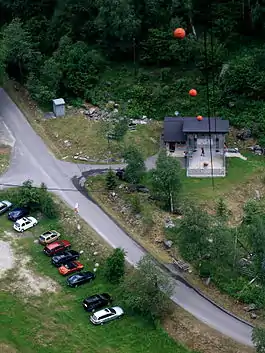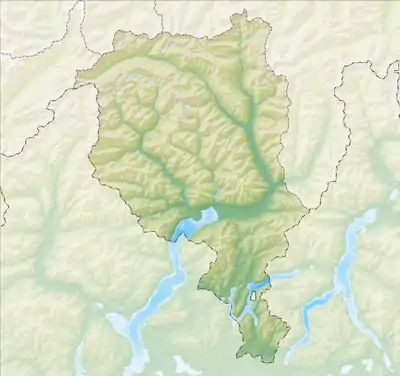Gresso
Gresso is a former municipality in the district of Locarno in the canton of Ticino in Switzerland. The municipality was formed in 1882 by splitting from Vergeletto. On 10 April 2016 the former municipalities of Vergeletto, Gresso, Mosogno and Isorno merged into the municipality of Onsernone.[2]
Gresso | |
|---|---|
 | |
 Coat of arms | |
Location of Gresso | |
 Gresso  Gresso | |
| Coordinates: 46°13′N 8°37′E | |
| Country | Switzerland |
| Canton | Ticino |
| District | Locarno |
| Government | |
| • Mayor | Sindaco |
| Area | |
| • Total | 11.1 km2 (4.3 sq mi) |
| Elevation | 996 m (3,268 ft) |
| Population (December 2004) | |
| • Total | 35 |
| • Density | 3.2/km2 (8.2/sq mi) |
| Time zone | UTC+01:00 (Central European Time) |
| • Summer (DST) | UTC+02:00 (Central European Summer Time) |
| Postal code(s) | 6611 |
| SFOS number | 5109 |
| Surrounded by | Maggia, Onsernone, Vergeletto |
| Website | SFSO statistics |
History
The discovery of a Roman tomb from the 1st-2nd century AD, with pottery and coins, proves that Gresso was part of the outer-most reaches of the Vicus of Muralto. The modern village of Gresso is first mentioned in 1316 as Agrassio.[3] Until 1803, Gresso was part of the Squadra of Russo (now Onsernone), one of five Squadre, that formed the medieval community of Onsernone.
The village church has always been part of the parish of Vergeletto. The Chapel of S. Orsola was built in 1703 and rebuilt in 1730. It was renovated in the late 20th century.[3]
The village didn't have a drivable road until 1885. The local economy was based on agriculture, animal husbandry, and, for a time, emigration. Most of the population is elderly, the few younger residents have either moved away or commute to Locarno.[3]
Geography
Gresso had an area, as of 1997, of 11.08 square kilometers (4.28 sq mi). Of this area, 0.17 km2 (0.066 sq mi) or 1.5% is used for agricultural purposes, while 6.77 km2 (2.61 sq mi) or 61.1% is forested. Of the rest of the land, 0.09 km2 (22 acres) or 0.8% is settled (buildings or roads), 0.19 km2 (0.073 sq mi) or 1.7% is either rivers or lakes and 1.77 km2 (0.68 sq mi) or 16.0% is unproductive land.
Of the built up area, housing and buildings made up 0.3% and transportation infrastructure made up 0.4%. Out of the forested land, 52.2% of the total land area is heavily forested and 5.7% is covered with orchards or small clusters of trees. Of the agricultural land, 1.3% is used for growing crops. All the water in the municipality is flowing water. Of the unproductive areas, 11.1% is unproductive vegetation and 4.9% is too rocky for vegetation.[4]
The former municipality is located in the Locarno district, at an elevation of 999 m (3,278 ft) on the steep, left side of the Vergeletto valley.
Coat of arms
The blazon of the municipal coat of arms is Azure a dove displayed argent and in a chief of the last a cross gules.[5]
Demographics
Gresso had a population (as of 2014) of 41. As of 2008, 3.7% of the population are resident foreign nationals.[6] Over the last 10 years (1997–2007) the population has changed at a rate of -38.6%.
Most of the population (as of 2000) speaks Italian (94.3%), with German and French making up the rest (2.9% each).[7] Of the Swiss national languages (as of 2000), 1 person speaks German, 1 person speaks French and 33 people speak Italian.[8]
As of 2008, the gender distribution of the population was 50.0% male and 50.0% female. The population was made up of 15 Swiss men and 15 Swiss women.[9]
The age distribution, as of 2009, in Gresso is; 2 children or 6.7% of the population are between 0 and 9 years old and there are no teenagers. Of the adult population, 1 person is between 20 and 29 years old. 4 people or 13.3% are between 30 and 39, 1 person is between 40 and 49, and 6 people or 20.0% are between 50 and 59. The senior population distribution is 7 people or 23.3% of the population are between 60 and 69 years old, 6 people or 20.0% are between 70 and 79, there are 3 people or 10.0% who are over 80.[9]
As of 2000, there were 19 private households in the municipality, and an average of 1.8 persons per household.[7] In 2000 there were 72 single family homes (or 88.9% of the total) out of a total of 81 inhabited buildings. There were 7 two family buildings (8.6%) and there were also 2 buildings in the municipality that were multipurpose buildings (used for both housing and commercial or another purpose).[10]
The vacancy rate for the municipality, in 2008, was 0%. In 2000 there were 89 apartments in the municipality. The most common apartment size was the 2 room apartment of which there were 27. There were 4 single room apartments and 9 apartments with five or more rooms.[11] Of these apartments, a total of 19 apartments (21.3% of the total) were permanently occupied, while 69 apartments (77.5%) were seasonally occupied and 1 apartments (1.1%) were empty.[11] As of 2007, the construction rate of new housing units was 0 new units per 1000 residents.[7]
The historical population is given in the following table:[3][12]
| year | population |
|---|---|
| 1888 | 290 |
| 1900 | 278 |
| 1950 | 139 |
| 1970 | 68 |
| 1990 | 48 |
| 2000 | 35 |
Sights
The entire village of Gresso is designated as part of the Inventory of Swiss Heritage Sites.[13]
Politics
In the 2007 federal election the most popular party was the FDP which received 57.74% of the vote. The next three most popular parties were the SP (27.98%), the Ticino League (9.52%) and the CVP (4.76%). In the federal election, a total of 21 votes were cast, and the voter turnout was 58.3%.[14]
In the 2007 Gran Consiglio election, there were a total of 37 registered voters in Gresso, of which 19 or 51.4% voted. The most popular party was the PLRT which received 13 or 68.4% of the vote. The next two most popular parties were; the PS (with 4 or 21.1%), the PPD+GenGiova (with 1 or 5.3%).[15]
In the 2007 Consiglio di Stato election, The most popular party was the PLRT which received 13 or 68.4% of the vote. The next two most popular parties were; the PS (with 4 or 21.1%), the LEGA (with 1 or 5.3%).[15]
Economy
As of 2007, Gresso had an unemployment rate of 4.49%. As of 2005, no one was employed in the primary economic sectoror the secondary sector. 1 person was employed in the tertiary sector, with 1 business in this sector.[7] There were 12 residents of the municipality who were employed in some capacity, of which females made up 58.3% of the workforce.
In 2000, there were 8 workers who commuted away from the municipality.[16] Of the working population, 16.7% used public transportation to get to work, and 50% used a private car.[7]
Religion
From the 2000 census, 32 or 91.4% were Roman Catholic, while or 0.0% belonged to the Swiss Reformed Church. There are 1 individuals (or about 2.86% of the population) who belong to another church (not listed on the census), and 2 individuals (or about 5.71% of the population) did not answer the question.[8]
Education
The entire Swiss population is generally well educated. In Gresso about 64.7% of the population (between age 25–64) have completed either non-mandatory upper secondary education or additional higher education (either university or a Fachhochschule).[7]
As of 2000, there were 2 students from Gresso who attended schools outside the municipality.[16]
References
- "Arealstatistik Standard - Gemeinden nach 4 Hauptbereichen". Federal Statistical Office. Retrieved 13 January 2019.
- Amtliches Gemeindeverzeichnis der Schweiz published by the Swiss Federal Statistical Office (in German). Retrieved 27 April 2016
- Gresso in German, French and Italian in the online Historical Dictionary of Switzerland.
- Altitudine, superficie, secondo il genere di utilizzazione, rilevazione 1992/1997, e densità della popolazione, nel 2000 (in Italian). Retrieved 25 October 2010
- Flags of the World.com. Retrieved 2 December 2010
- Swiss Federal Statistical Office – Superweb database – Gemeinde Statistics 1981-2008 Archived 28 June 2010 at the Wayback Machine (in German). Retrieved 19 June 2010
- Swiss Federal Statistical Office Archived 5 January 2016 at the Wayback Machine. Retrieved 2 December 2010
- Popolazione residente, secondo la lingua principale e la religione, nel 2000 Archived 7 July 2011 at the Wayback Machine (in Italian). Retrieved 23 November 2010
- 01.02.03 Popolazione residente permanente Archived 7 July 2011 at the Wayback Machine (in Italian). Retrieved 23 November 2010
- 09.02.01 Edifici Archived 7 July 2011 at the Wayback Machine (in Italian). Retrieved 23 November 2010
- 09.02.02 Abitazioni Archived 7 July 2011 at the Wayback Machine (in Italian). Retrieved 23 November 2010
- Popolazione residente, dal 1850 Archived 7 July 2011 at the Wayback Machine (in Italian). Retrieved 23 November 2010
- "Kantonsliste A-Objekte:Ticino" (PDF). KGS Inventar (in German). Federal Office of Civil Protection. 2009. Archived from the original (PDF) on 6 July 2011. Retrieved 12 July 2010.
- Swiss Federal Statistical Office, Nationalratswahlen 2007: Stärke der Parteien und Wahlbeteiligung, nach Gemeinden/Bezirk/Canton Archived 14 May 2015 at the Wayback Machine (in German). Retrieved 28 May 2010
- Elezioni cantonali: Gran Consiglio, Consiglio di Stato Archived 7 July 2011 at the Wayback Machine (in Italian). Retrieved 23 November 2010
- Swiss Federal Statistical Office – Statweb (in German). Retrieved 24 June 2010
External links
- Gresso in German, French and Italian in the online Historical Dictionary of Switzerland.